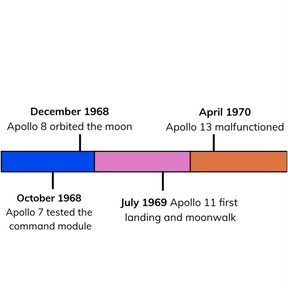
Interpreting a timeline
I can explain how information on a timeline helps you understand the text.



8,000 schools use Gynzy
92,000 teachers use Gynzy
1,600,000 students use Gynzy
General
In this lesson, students will learn how to read and interpret information from timelines. They will read several timelines, including the topics of Apollo and Helen Keller. They will close the lesson with a "human timeline" activity.
Standards
CCSS.ELA-Literacy.RI.4.7
Learning objective
Students will be able to explain how information on a timeline helps you understand the text.
Introduction
Review different text features, such as graphs, highlighting, diagrams, maps, pictures, and captions. Discuss what it means to put something in chronological order. Students will place numbers in order from least to greatest on a number line. Explain why timelines are important.
Instruction
Students will read a timeline titled "Manned Apollo Flights." Explain that the earliest and latest event dates determine the amount of time the timeline covers. Students will read a timeline and answer questions by dragging pictures to their corresponding events.
Next, students will read a passage about Helen Keller and take note of the dates. They will drag the dates to the events on the timeline of "Helen's Life - Birth to College." Then, students will answer questions about a timeline titled, "Helen Meets Anne."
Quiz
Students will answer ten questions which ask them to place years on a timeline, how to order years on a timeline, and to determine when something happened according to a timeline.
Closing
Students will review what they learned about timelines and answer short questions. Lastly, they will make a "human timeline" of the years that states gained statehood.
Instruction materials
- paper (or something else to write on) to make signs for the Closing activity
The online teaching platform for interactive whiteboards and displays in schools
Save time building lessons
Manage the classroom more efficiently
Increase student engagement
Discover more!
About Gynzy
Gynzy is an online teaching platform for interactive whiteboards and displays in schools.
With a focus on elementary education, Gynzy’s Whiteboard, digital tools, and activities make it easy for teachers to save time building lessons, increase student engagement, and make classroom management more efficient.



